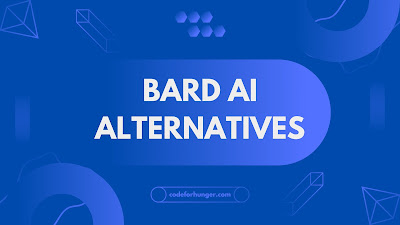AI technology has revolutionized various industries, and the field of conversational agents is no exception. Among the many AI chatbot solutions available, Bard AI has gained popularity for its dynamic and engaging conversations. However, as technology constantly evolves, there is a growing demand for alternatives to Bard AI. In this article, we will explore the top 10 Bard AI alternatives that can cater to various user needs.
What is Bard AI?
Bard AI, a robust conversational AI system developed by OpenAI, has made waves in the industry with its natural language processing capabilities. It is trained on a vast corpus of text and is designed to generate human-like responses, making interactions with it feel organic and lifelike. Bard AI has become a favorite tool for users seeking AI-powered conversation partners.
Why are people looking for alternatives?
While Bard AI has undoubtedly offered incredible conversational experiences, some users may find themselves seeking alternatives for various reasons. One reason is the need for diversity in conversational styles. While Bard AI excels in its conversational abilities, some users desire alternative AI chatbots that offer new perspectives and tones. Additionally, different users may have specific requirements that Bard AI might not fully meet, leading them to explore other options.
Top 10 Alternatives
Here are the top 10 Bard AI alternatives that deserve a closer look:
1. ChatGPT
ChatGPT is developed by OpenAI, and it is a formidable rival to Bard AI. Its advanced conversational abilities and natural language understanding have garnered significant acclaim. Leveraging large-scale pre-training, ChatGPT can engage users in meaningful discussions and provide insightful responses.
⟹Visit the Official Website of ChatGPT
2. Jasper AI
Jasper AI distinguishes itself with an innovative approach to conversation. By blending deep learning and reinforcement learning techniques, it offers an immersive and dynamic conversational experience. Users appreciate Jasper AI for its ability to simulate human-like emotions, creating an engaging dialogue.
⟹Visit the Official Website of Jasper AI
3. Perplexity AI
Perplexity AI combines powerful language models with reinforced learning, producing detailed and elaborate responses. Its nuanced understanding of context allows for in-depth conversations that can explore various topics effortlessly. Users looking for a conversational agent with an extensive knowledge base will find Perplexity AI intriguing.
⟹Visit the Official Website of Perplexity AI
4. YouChat
YouChat focuses on personalization and adaptability, allowing users to customize its conversational style to their liking. Its versatile architecture empowers users to create unique chatbots that suit their specific needs. Furthermore, YouChat seamlessly integrates with various messaging platforms, enhancing its accessibility.
⟹Visit the Official Website of YouChat
5. KoalaChat
KoalaChat stands out for its exceptional user interface, offering a visually pleasing and user-friendly experience. Its conversational capabilities are also impressive, allowing users to engage in natural and dynamic conversations. KoalaChat's intuitive design and human-like interactions make it a compelling alternative.
⟹Visit the Official Website of KoalaChat
6. ChatSonic
Chatsonic is built to address the limitations of ChatGPT. Known for its lightning-fast response times, ChatSonic utilizes advanced neural networks to generate rapid and contextually appropriate replies. It excels in maintaining conversational flow and effortlessly adapts to users' inputs. Those seeking prompt and efficient conversations will find ChatSonic appealing.
⟹Visit the Official Website of ChatSonic
7. Pi
Pi is an AI chatbot alternative that focuses on personal growth and emotional well-being. Guided by the principles of positive psychology and cognitive-behavioral therapy, Pi offers supportive conversations aimed at empowering users and nurturing self-improvement.
⟹Visit the Official Website of Pi
8. Microsoft Bing AI
Microsoft has added Artificial Intelligence to its search engine, which is now called Bing AI. As a strong contender in the chatbot arena, Microsoft Bing AI showcases its vast knowledge base and sophisticated language understanding. Users appreciate its ability to provide accurate answers and its seamless integration with Microsoft's suite of products.
To use it, simply open bing.com and click on the chat option located in the navigation bar.
⟹Visit the Official Website of Bing AI
9. GitHub Copilot
GitHub Copilot, specifically designed for developers, brings AI assistance directly into coding workflows. Its ability to generate code suggestions and anticipate developer intent has made it a favorite among many programmers. GitHub Copilot streamlines the coding process, making it an invaluable tool for software development.
⟹Visit the Official Website of GitHub Copilot
10. Amazon CodeWhisperer
Amazon CodeWhisperer combines AI-guided coding assistance with a conversational interface, allowing developers to intuitively communicate with their coding environment. With its vast codebase and contextual understanding, CodeWhisperer enhances productivity and enables developers to write cleaner and more efficient code.
⟹Visit the Official Website of Chatspin Amazon CodeWhisperer
Conclusion
The landscape of AI-powered chatbots is constantly evolving, and as we look to 2023, there are several promising alternatives to Bard AI. The top 10 alternatives discussed in this article provide a diverse range of conversational experiences, catering to different user preferences and requirements. Whether users seek engaging conversations, rapid responses, emotional support, or coding assistance, these alternatives offer compelling options worth exploring.
Recommendations for users
For users evaluating alternative AI chatbots, it is recommended to consider their specific needs and priorities. Experimenting with different alternatives and assessing their conversational depth, language processing capabilities, and customization options can provide valuable insights. Additionally, user reviews and feedback can be instrumental in understanding the strengths and weaknesses of each alternative. Ultimately, users should choose the alternative that aligns best with their desired conversational experience and enhances their overall interaction.


No comments:
Post a Comment
If you have any doubts, please discuss here...👇